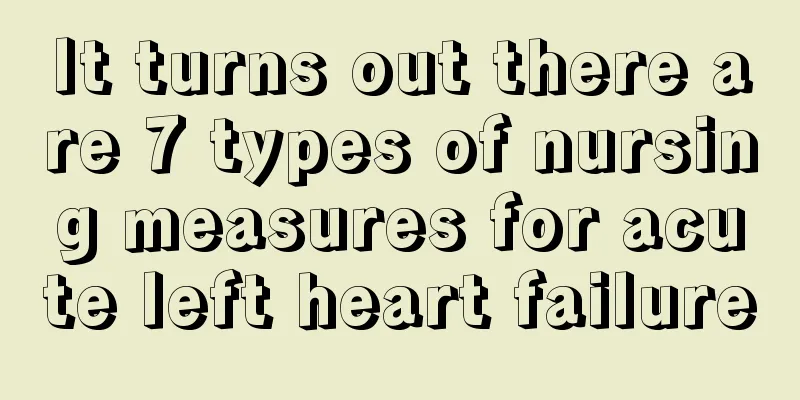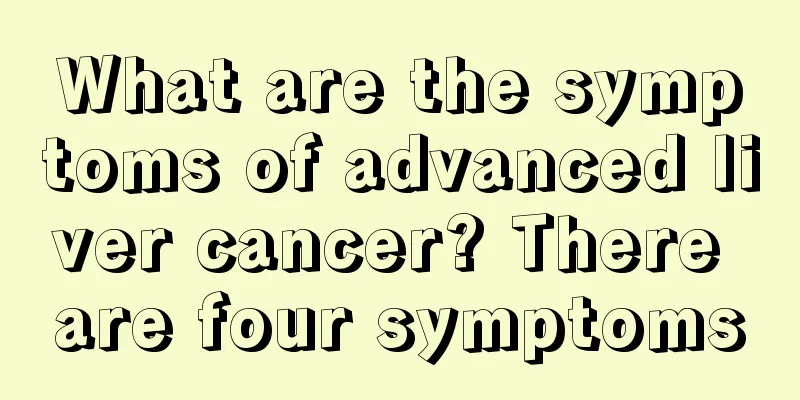It turns out there are 7 types of nursing measures for acute left heart failure

|
Acute left heart failure is a disease that has become more common in recent years. If rescue is not timely or care is not in place, it will pose a threat to the patient's life. Therefore, it is very important for the patient's family to understand the nursing measures for acute left heart failure. In fact, there are many kinds of nursing measures for acute left heart failure, and everyone must remember them. 1. Nursing measures for acute left heart failure: 1. Psychological care 2. General care: a. Posture, sitting, and lowering of legs → less blood returning to the heart b. Rest; c. Diet: low salt, low fat, easy to digest, multivitamin (containing potassium and magnesium), and multifiber; 3. Oxygen inhalation: 6-8 L/min, add 20-30% alcohol; 4. Drug treatment: a. Sedation: 5-10 mg of diazepam, 50-100 mg of pethidine, and 5-10 mg of morphine, subcutaneously injected. b. Cardiotonic: 0.2-0.4 mg of digoxin is injected intravenously to enhance myocardial contractility → increase cardiac output; c. Diuretic: 20-40 mg of furosemide; d. Vasodilator: 5-10 mg of nitroglycerin is administered by intravenous drip. e. Aminophylline: 0.25 mg intravenous push, in addition to the effect of bronchial dilation, can directly excite the myocardium, relieve bronchospasm, and enhance the effects of diuretic, cardiotonic, and vasodilator drugs. f. Hormone: Dxm 10-20 mg intravenously. Reduce peripheral resistance → decrease blood return to the heart → relieve bronchospasm. 5. Record 24-hour intake and output; 6. Strengthen skin and oral care; 7. Keep bowel movements smooth: Increased intra-abdominal pressure → increased burden on the heart → increased myocardial hypoxia; and due to excessive vagus nerve tension, reflexive arrhythmia → life-threatening; 8. Control the intravenous fluid infusion rate: 20-30 drops/minute; 9. Closely observe the changes in the patient's condition: a. Changes in vital signs, cyanosis and pulmonary signs; b. Toxic reactions of digitalis drugs. 2. Diagnosis of acute left heart failure: 1. Insufficient cardiac output: caused by acute heart failure; 2. Impaired gas exchange: associated with acute pulmonary edema; 3. Fear: related to a feeling of suffocation and difficulty breathing; 4. Lack of activity endurance: related to decreased cardiac output and dyspnea; 5. Ineffectiveness of clearing the respiratory tract: related to large amounts of foamy sputum; 6. Excessive body fluid: Lower limb edema: related to systemic congestion; 7. Potential complications: cardiogenic shock, sudden death, digitalis poisoning |
<<: Can you drink beer when you have a cold or fever? Beer lovers must know this
>>: This is what causes onychomycosis on the big toe
Recommend
What is the reason for the sudden onset of heartache?
Posterior heart pain mainly refers to pain in the...
Under what circumstances should surgery for hamartoma be performed
Speaking of hamartoma, I believe many people have...
What to do if your toes crack
In this hot summer, most of our friends have put ...
Good care should be taken before prostate cancer surgery
Prostate cancer is a terrible cancer. Many patien...
What are some tips for washing your face
Many of us may often have various problems such a...
How to improve the cure rate of osteosarcoma
Many patients know that osteosarcoma is currently...
When is the best time to brush your teeth?
We brush our teeth every day, and we all know tha...
How long can you live if lung cancer recurs
How long can you live if lung cancer recurs? 1. I...
What to do if your skin is allergic to mango
Mango is rich in nutrients and is a fruit that pe...
Hair loses color seriously after waxing and washing
In this age where appearance is everything, most ...
What is the reason for low neutrophil count
One of the items in the routine blood test is abo...
Where is the blood stasis in the veins under the tongue?
The tongue is related to people's physical he...
How to preserve fresh whitebait
Whitebait is a kind of freshwater and saltwater f...
Hand-warming mouse, the advantages of hand-warming mouse
Many people are familiar with hand-warming mouse....
Will I get sick if I stay alone for too long?
Some people may like a quieter life, so they like...









